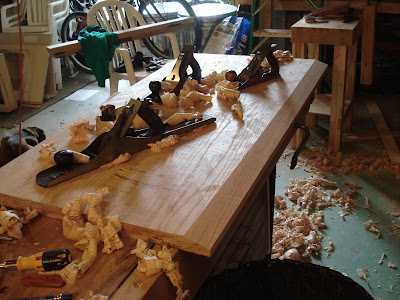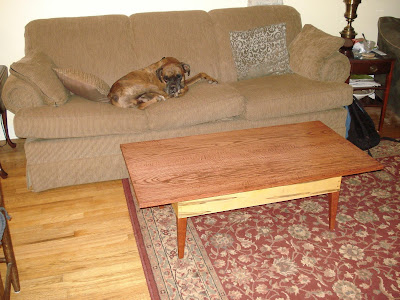Then came the fun part: working the tabletop. I started with the aforementioned big ole' slab of oak...
...and cut it in two...
...jointed the adjacent edges and glued them together:
Then I just used the circular saw to cut the length and width that I needed:
A lot of planing later, the top was smooth, flat, and showed a fair amount of figuring in places:
Jointing the edges of a slab this big is a little more difficult that most pieces. Planes are meant to be used at belt height which wasn't really doable here:
I then started putting the bevel around the underside; here's one edge complete:
The process starts by using an angled fence on the skew block plane to establish the angle of the bevel.
The jointer and fore plane then taken that bevel even further down...
...which provides a good foundation for the scrub plane to come in and hog out lots of stock.
I then come back with the jointer and then the smoothing plane to finish the edge.
I couldn't wait to see what the stained top would look like, so I went ahead and put on a coat or two.
It became obvious that the surface wasn't quite smooth enough yet. If you look closely at the above photo you can see plane tracks running across the top.
Only one thing to do...
...plane it down and start over. The next time I finished it off with a cabinet scraper and it worked out well.
Next I made the brackets that hold the top to the apron. This just involved planing a rebate into a piece of wood...
...cutting that wood into little blocks...
...and installing them in the groove running around the inside of the apron. Screws driven through these blocks and into the bottom of the tabletop hold everything together firmly but still allow for seasonal wood movement. Here you can also see how the legs are attached...glue is involved too.The oak is stained with Minwax "Chestnut Red" and the tabletop has some polyurethane on it. The maple is rubbed with Watco Danish Oil in "Golden Oak."
In situ:
With the installed drawer pull.
Really ties the room together, does it not? Or could that just be the rug?



















Looks great! I love the table. Now, what would REALLy tie the room together is a matching side table besire the couch (hint-hint). :-)
ReplyDelete~ the wife
Dude, that rug really tied the room together. ;) Table looks beautiful!
ReplyDeleteCONGRATULATIONS ON YOUR BEAUTIFUL NEW DAUGHTER, JOHN!!!
ReplyDeleteLove, Sarah (the sister)